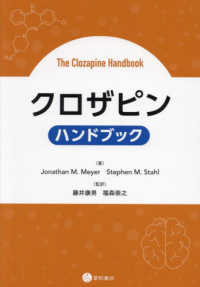Full Description
Educating for Sustainable Development (ESD) approaches are holistic and interdisciplinary, values-driven, participatory, multi-method, locally relevant and emphasize critical thinking and problem-solving. This book explains how ESD approaches work in the Japanese context; their effects on different stakeholders; and their ultimate potential contribution to society in Japan. It considers ESD in both formal and informal education sectors, recognizing that even when classroom learning takes place it must be place-based and predicated on a specific community context. The book explores not only 'Why ESD', but why and how ESD in Japan has gained importance in the past decade and more recently in the wake of the triple disaster of March 2011. It considers how ESD can help Japan recover and adapt to disasters and take initiative in building more resilient and sustainable communities.
This volume asks the questions: What are some examples of positive contributions by ESD to sustainability in Japan? What is the role of ESD in Japan in activating people to demand and work towards change? How can schools, universities and non-governmental organizations link with communities to strengthen civic awareness and community action? After an introduction that elucidates the roots and recent promotion of ESD in Japan, part one of this volume looks at the formal education sector in Japan, while part two examines community-based education and sustainability initiatives. The latter revisits the Tohoku region five years on from the events of March 2011, to explore recovery and revitalization efforts by schools, NGOs and residents.
This is an invaluable book for postgraduate students, researchers, teachers and policy makers working on ESD.
Contents
IntroductionTop-down and bottom-up ESD: divergence and convergence of Japanese ESD discourses and practices
Yoko Mochizuki
Part I: School-based approaches
Chapter 1. Formal ESD in Japan: dissolving walls between classroom and community
Jane Singer and Yoshiyuki Nagata
Chapter 2. Implications of 3.11 for disaster education and education for sustainable development in Japan
Aiko Sakurai and Rajib Shaw
Chapter 3. Assessing sustainability learning and practice at Moriyama High School, Shiga, Japan
Yi Zhou and Jane Singer
Chapter 4. Globalising school education in Japan: an investigation using the academic ability model
Toshiya Kodama
Chapter 5. Perspectives on education for sustainable development through local cultural heritage
Shizuo Nakazawa and Tadashi Izumitani
Chapter 6. An investigation into fairness and bias in educational materials produced by the Japanese government to teach school children about nuclear power and radiation
Shinobu Goto
Chapter 7. Collaborating for change: teaching and assessing a university community sustainability course in Japan and Vietnam
Tracey Gannon, Jane Singer and Benjamin McLellan
Part II: Community-based approaches
Chapter 8. Community-based, non-formal and informal ESD in Japan: where top-down and bottom-up approaches meet
Fumiko Noguchi and Toyoshi Sasaki
Chapter 9. Can civil society revitalise dying rural villages? The case of Kamiseya in Kyoto prefecture
Binxian Ji and Katsue Fukamachi
Chapter 10. Multi-stakeholder community education through environmental learning programmes in Nishinomiya
Miki Yoshizumi
Chapter 11. From challenge to opportunity: Japanese non-profit organisations harness post-3.11 civic engagement Sarajean Rossitto
Chapter 12. A radical approach from the periphery: informal ESD through rights recovery for indigenous AinuFumiko Noguchi
Chapter 13. The Tohoku Green Renaissance Project - networking green rebuilding activities after a mega-disaster
Tsubasa Iwabuchi and Noriko Takemoto
Chapter 14. The importance of genfukei (spirit of place) to citizen participation in community building in Zushi city Koichi Nagashima
Chapter 15. Exploring the values of rural communities through place-based education in Niigata prefecture
Takako Takano
Postscript. Reflections on visions of rebuilding Tohoku: the future of ESD as a response to risk in JapanYoko Mochizuki with Makoto Hatakeyama








